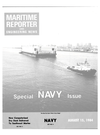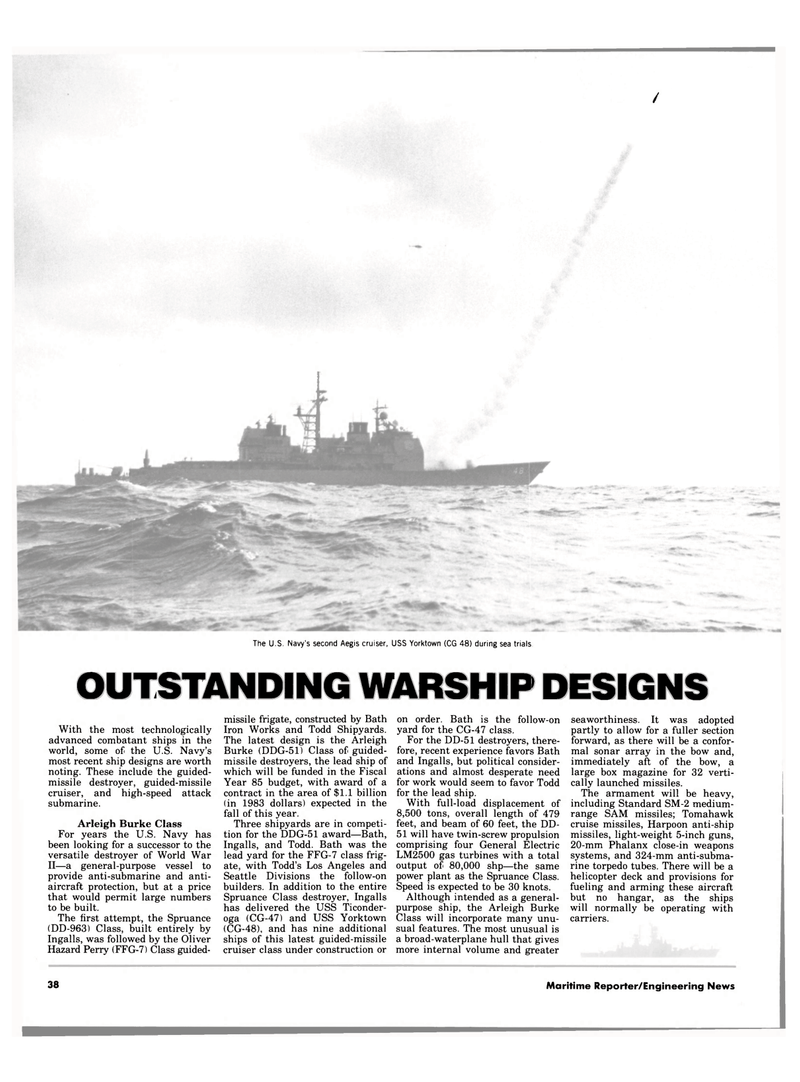
Page 36: of Maritime Reporter Magazine (August 15, 1984)
Read this page in Pdf, Flash or Html5 edition of August 15, 1984 Maritime Reporter Magazine
/
The U.S. Navy's second Aegis cruiser, USS Yorktown (CG 48) during sea trials
OUTSTANDING WARSHIP DESIGNS
With the most technologically advanced combatant ships in the world, some of the U.S. Navy's most recent ship designs are worth noting. These include the guided- missile destroyer, guided-missile cruiser, and high-speed attack submarine.
Arleigh Burke Class
For years the U.S. Navy has been looking for a successor to the versatile destroyer of World War
II—a general-purpose vessel to provide anti-submarine and anti- aircraft protection, but at a price that would permit large numbers to be built.
The first attempt, the Spruance (DD-963) Class, built entirely by
Ingalls, was followed by the Oliver
Hazard Perry (FFG-7) Class guided- missile frigate, constructed by Bath
Iron Works and Todd Shipyards.
The latest design is the Arleigh
Burke (DDG-51) Class of guided- missile destroyers, the lead ship of which will be funded in the Fiscal
Year 85 budget, with award of a contract in the area of $1.1 billion (in 1983 dollars) expected in the fall of this year.
Three shipyards are in competi- tion for the DDG-51 award—Bath,
Ingalls, and Todd. Bath was the lead yard for the FFG-7 class frig- ate, with Todd's Los Angeles and
Seattle Divisions the follow-on builders. In addition to the entire
Spruance Class destroyer, Ingalls has delivered the USS Ticonder- oga (CG-47) and USS Yorktown (CG-48), and has nine additional ships of this latest guided-missile cruiser class under construction or on order. Bath is the follow-on yard for the CG-47 class.
For the DD-51 destroyers, there- fore, recent experience favors Bath and Ingalls, but political consider- ations and almost desperate need for work would seem to favor Todd for the lead ship.
With full-load displacement of 8,500 tons, overall length of 479 feet, and beam of 60 feet, the DD- 51 will have twin-screw propulsion comprising four General Electric
LM2500 gas turbines with a total output of 80,000 shp—the same power plant as the Spruance Class.
Speed is expected to be 30 knots.
Although intended as a general- purpose ship, the Arleigh Burke
Class will incorporate many unu- sual features. The most unusual is a broad-waterplane hull that gives more internal volume and greater seaworthiness. It was adopted partly to allow for a fuller section forward, as there will be a confor- mal sonar array in the bow and, immediately aft of the bow, a large box magazine for 32 verti- cally launched missiles.
The armament will be heavy, including Standard SM-2 medium- range SAM missiles; Tomahawk cruise missiles, Harpoon anti-ship missiles, light-weight 5-inch guns, 20-mrn Phalanx close-in weapons systems, and 324-mm anti-subma- rine torpedo tubes. There will be a helicopter deck and provisions for fueling and arming these aircraft but no hangar, as the ships will normally be operating with carriers. 38 Maritime Reporter/Engineering News

 35
35

 37
37
